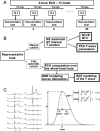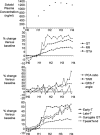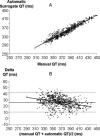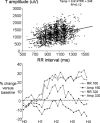The time course of new T-wave ECG descriptors following single- and double-dose administration of sotalol in healthy subjects
- PMID: 20146779
- PMCID: PMC6932454
- DOI: 10.1111/j.1542-474X.2009.00336.x
The time course of new T-wave ECG descriptors following single- and double-dose administration of sotalol in healthy subjects
Abstract
Introduction: The aim of the study was to assess the time course effect of IKr blockade on ECG biomarkers of ventricular repolarization and to evaluate the accuracy of a fully automatic approach for QT duration evaluation.
Methods: Twelve-lead digital ECG Holter was recorded in 38 healthy subjects (27 males, mean age = 27.4 + or - 8.0 years) on baseline conditions (day 0) and after administration of 160 mg (day 1) and 320 mg (day 2) of d-l sotalol. For each 24-hour period and each subject, ECGs were extracted every 10 minutes during the 4-hour period following drug dosage. Ventricular repolarization was characterized using three biomarker categories: conventional ECG time intervals, principal component analysis (PCA) analysis on the T wave, and fully automatic biomarkers computed from a mathematical model of the T wave.
Results: QT interval was significantly prolonged starting 1 hour 20 minutes after drug dosing with 160 mg and 1 hour 10 minutes after drug dosing with 320 mg. PCA ventricular repolarization parameters sotalol-induced changes were delayed (>3 hours). After sotalol dosing, the early phase of the T wave changed earlier than the late phase prolongation. Globally, the modeled surrogate QT paralleled manual QT changes. The duration of manual QT and automatic surrogate QT were strongly correlated (R(2) = 0.92, P < 0.001). The Bland and Altman plot revealed a nonstationary systematic bias (bias = 26.5 ms + or - 1.96*SD = 16 ms).
Conclusions: Changes in different ECG biomarkers of ventricular repolarization display different kinetics after administration of a potent potassium channel blocker. These differences need to be taken into account when designing ventricular repolarization ECG studies.
Figures




Similar articles
-
Identifying drug-induced repolarization abnormalities from distinct ECG patterns in congenital long QT syndrome: a study of sotalol effects on T-wave morphology.Drug Saf. 2009;32(7):599-611. doi: 10.2165/00002018-200932070-00006. Drug Saf. 2009. PMID: 19530746 Clinical Trial.
-
Investigating the effect of sotalol on the repolarization intervals in healthy young individuals.J Electrocardiol. 2008 Nov-Dec;41(6):595-602. doi: 10.1016/j.jelectrocard.2008.06.013. Epub 2008 Sep 17. J Electrocardiol. 2008. PMID: 18801493 Clinical Trial.
-
Comparing methods of measurement for detecting drug-induced changes in the QT interval: implications for thoroughly conducted ECG studies.Ann Noninvasive Electrocardiol. 2004 Apr;9(2):166-74. doi: 10.1111/j.1542-474X.2004.92542.x. Ann Noninvasive Electrocardiol. 2004. PMID: 15084215 Free PMC article. Clinical Trial.
-
Identify drug-induced T wave morphology changes by a cell-to-electrocardiogram model and validation with clinical trial data.J Electrocardiol. 2009 Nov-Dec;42(6):534-42. doi: 10.1016/j.jelectrocard.2009.07.010. Epub 2009 Aug 22. J Electrocardiol. 2009. PMID: 19700171
-
Rate dependence of sotalol-induced prolongation of ventricular repolarization during exercise in humans.Circulation. 1991 Feb;83(2):536-45. doi: 10.1161/01.cir.83.2.536. Circulation. 1991. PMID: 1846784 Clinical Trial.
Cited by
-
Use of Mobile Devices to Measure Outcomes in Clinical Research, 2010-2016: A Systematic Literature Review.Digit Biomark. 2018 Jan 31;2(1):11-30. doi: 10.1159/000486347. eCollection 2018 Jan-Apr. Digit Biomark. 2018. PMID: 29938250 Free PMC article. Review.
References
-
- Crouch MA, Limon L, Cassano AT. Clinical relevance and management of drug‐related QT interval prolongation. Pharmacotherapy 2003;23:881–908. - PubMed
-
- Ray WA, Murray KT, Meredith S, et al Oral erythromycin and the risk of sudden death from cardiac causes. N Engl J Med 2004;351:1089–1096. - PubMed
-
- Curtis LH, Ostbye T, Sendersky V, et al Prescription of QT‐prolonging drugs in a cohort of about 5 million outpatients. Am J Med 2003;114:135–141. - PubMed
-
- International Conference on Harmonisation (ICH): The clinical evaluation of QT/QTc interval prolongation and proarrhythmic potential for non‐antiarrhythmic drugs. http://www.fda.gov/cder/guidance/6922fnl.pdf last accessed August 21st 2008. - PubMed
-
- Redfern WS, Carlsson L, Davis AS, et al Relationships between preclinical cardiac electrophysiology, clinical QT interval prolongation and torsade de pointes for a broad range of drugs: Evidence for a provisional safety margin in drug development. Cardiovasc Res 2003;58:32–45. - PubMed
MeSH terms
Substances
LinkOut - more resources
Full Text Sources

